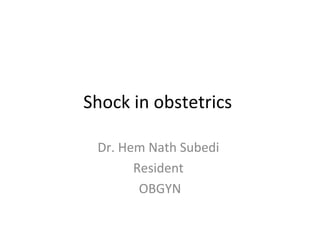
Shock in obstetrics
- 1. Shock in obstetrics Dr. Hem Nath Subedi Resident OBGYN
- 2. Definition • Shock is a critical condition an da life threatening medical emergency. • Shock results from acute , generalized , inadequate perfusion of below the tissues needed to deliver the oxygen and nutrient for normal.
- 3. Classification 1. Hypovolemic or hemorrhegic 2. Septic shock 3. Cardiogenic shock 4. Distributive shock
- 5. Pathophysiology • Untreated shock progresses through three stages as shown in below table. • inadequate management allows shock to progressively worsen passing through until death occurs.
- 6. Diagnosis • There are no laboratory test for shock • A high index of susupicion and physical signs of inadequate tissue perfusion and oxygenation are the basis for initiating prompt management. • Initial management does not rely on knowledge of the underlying cause.
- 7. Initial management • Maintain ABC • Airway should assured - oxygen 15lt/min. • Breathing – ventilation should be checked and support if inadequate • Circulation- (with control of hemorrhage) – Two wide bore canulla – Restore circulatory volume and reverse hypotention with crystalloid. – Crossmatch, arrange and give blood if necessary. – See for response such as , vital signs
- 8. Hemorrhegic shock • Causes • Antenatal – Ruptured ectopic pregancy – Incomplete abortion – Placenta previa – Placental abruption – Uterine rupture • Post partum – Uterine atony – Laceration to genital tract – Chorioamnionitis – Coagulopathy – Retained placental tissue
- 9. Management • As above measurement for basic shock management then treat specific cause. • Laparotomy for ectopic pregnancy • Sucction evacution for incomplete abortion . • management of uterine atony – Optimise uterine tone- give uterotonic agent – Surgery- blynch suture, balloon catheter etc. • Repair of laceration • Management of uterine rupture – Stop oxytoin infusion if running – Continuous maternal and fetal monitoring – Emergency laparotomy with rapid operative delivery – Cesarean hysterectomy may need to perform if hemorrhage is not controlled.
- 11. Management of hemorrhegic shock contd… • Management of uterine inversion. – Replacement of the uterus needs to be undertaken quickly as delay makes replacement more difficult. – Administer toloclytics to allow uterine relaxation. – Replacement under taken ( with placenta if still attached)-manually by slowly and steadily pushingupwards, with hydrostatic pressure or surgically.
- 13. SEPTIC SHOCK • This is sepsis with hypotention despite adequate fluid resuscitation. • To diagnose septic shock following two criteria must be met – Evidence of infection through a positive blood culture. – Refractory hypotention- hypotention despite of adequate fluid resuscitation.
- 14. Predisposing factors for sepsis in obstetrics • Post cesarean delivery endoture of memetritis • Prolonged rupture of membranes • Retained products of conception • Cerclage in presence of rupture membraned • Intraamniotic infusion • Water birth • Retained product of conception • Urinary tract infection • Toxic shock syndrome • Necrotising Fascitis
- 15. Clinical features • Symptoms of sepsis – Abdominal pain – Vomiting – diarrhoea • Signs of sepsis – Tachycardia ,Pallor – Clamminess – Peripheral shutdown – Systemic inflammation – Fever or hypothermia – Tachypnoea – Cold peripheries – Hypotention – Confuion – Oliguria – Altered mental state
- 16. Special aspects in management of septic shock • Transfer to a higher level facility . • Invasive monitoring will inevitably be necessary • Obtain blood culture , wound swab culture and vaginal swab culture. • Start broad spectrum antibiotics . • Removal of infected tissues .
- 17. Cardiogenic shock • Failure of heart to provide adequate output lead to tissue under perfussion. In addition to under perfusion , blood and tissue oxygenation can also be exacerbated because of the back pressure on lungs that lead to pulmonary edema. • Pregnancy puts progressive strain on the heart as progresses. • Preexisting cardiac disease places the parturient at particular risk. • Cardiac related death in pregnancy is the second most common cause of death in pregnancy.
- 18. Anaphylaxis • A seriout is rapid onset as allergic reaction that is rapid onset and may cause death. • It is a relatively uncommon event in pregnancy but has serious implications for bothmother and fetus.
- 19. Causes • Pharmacological agent- penicillin group of drugs • Insect stings • Foods • Latex
- 20. Pathophysiology
- 21. Clinical features • Cutaneous – Flushing, pruritis, urticaria , rhinitis, conjunctival erythema, lacrymation. • Cardiovascular – Cardiovascular collapse, hypotention, vasodialation and erythema, pale clammy cool skin, diaphoresis, nausea and vomiting • Respiratory – Stridor , wheezing, dyspnoea, cough, chest tightness, cyanosis, condusion. • Gastrointestinal – Nausea vomiting , abdominal pain , pelvic pain • Central nervous system – Hypotention – collapse with or without unconsiousness, dizziness , incontinence – Hypoxia – causes confusion.
- 22. Management • Immediate – Stop adm. of suspected agent and call for help – Airway maintenance – Circulation – Give epinephrine IM and repeat every 5-15min in titrated until improvement. – In severe hypotension intravenous epinephrine should be given. – Rapid intravascular volume expansion with crystalloid solution. • Secondary – If hypotension persist alternative vasopressor agent should use. – Atropine if persistant bradycardia – If bronchospasm persist nebulize with salbutamol – Antihistaminics – Steroids – All patient with anaphylactic shock should reffered to critical care
- 23. Distributive shock • In distributive shock there is no loss in intravascular volume or cardiac function. • The primary defect is massive vasodilation leading to relative hypovolemia, reduced perfusion pressure , so poorer flow to the tissues.
- 24. Causes • Spinal injuries- Neurogenic shock – Spinal cord injuries may produce hypotension and shock as a result of sympathetic nervous system dysfunction. – Resuscitation , vasopressor agent and atropine may required in management because spinal injury leads bradycardia due to unapposed vagal stimulation. • Anesthesia -High spinal block – Basic ABC managemengt – Ventilation if needed
- 25. • Thank you
Editor's Notes
- N